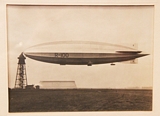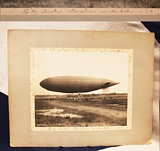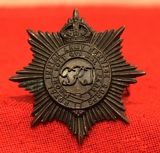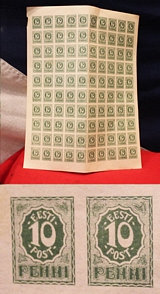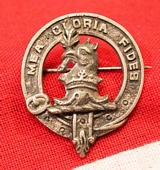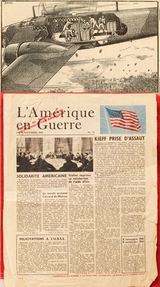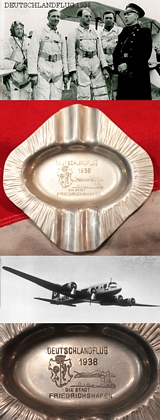WW1 / WW2 / 20th Century
Framed Original Photo of His Majesty's Airship R100,
His Majesty's Airship R100, known simply as R100, was a privately designed and built British rigid airship made as part of a two-ship competition to develop a commercial airship service for use on British Empire routes as part of the Imperial Airship Scheme. The other airship, the R101, was built by the British Air Ministry, but both airships were funded by the Government.
R100 was built by the Airship Guarantee Company, a specially created subsidiary of the armaments firm Vickers-Armstrongs, led by Commander Dennis Burney. The design team was headed by Barnes Wallis, later famous for his invention of the bouncing bomb and Knighted by the King. David Hawkins Senior, formerly of our family business, was Sir Barnes Wallis's bodyguard during his time that he served in the RAF. The design team also included Nevil Shute Norway as the senior stress engineer.
R100 first flew in December 1929. It made a series of trial flights and a successful return crossing of the Atlantic in July?August 1930, but following the crash of R101 in October 1930 the Imperial Airship Scheme was terminated and R100 was broken up for scrap. We show [for illustration only] a photo R100 over Canadian Bank of Commerce building in Toronto, Canada, then the highest building in the British Empire (August 1930). read more
135.00 GBP
Original Mounted Photograph of HM Airship Parseval PL18 In 1913
Photographed at Farnboro. Maiden flight: 23. April 1913
1913 delivered to the English Navy, under the marking "Parseval No.4". The Royal Navy described its service as very successful
Length: 80 m; diameter: 15 m; volume: 8800 m?.
Power plant: 2x 132 kW (180 PS) Maybach-engines, max speed 68 km/h,
Crew: 2 officers and 7 men. Radio and Weaponry installed
Served during the World War I first with the BEF then on the Western Front as a patrol ship, she was demobilised by the Royal Navy in July 1917. The original mounting card has some foxing but the photo has none and is good. Hand written in pencil on the mount. Dated 1913. Photo 19 x 24 cm, mount size 38 x 30cm read more
180.00 GBP
Royal Indian Army Service Corps Post 1921 Officer`s Cap Badge.
Part of the 7th Armoured Div. in WW2. logistical support of the Indian Army to keep the fighting forces supplied was a specialised activity over the decades and centuries. Original this was the job of the Supply Department and the Transport Departments, but these two units were merged to form the Royal Indian Army Service Corps in 1884. After Indian's independence in 1947 the RIASC became The Indian Army Service Corps. read more
45.00 GBP
Officers WW2 Glengarry Badge of the Black Watch Regt.
Very good condition, multi piece construction. During World War I the 25 battalions of Black Watch fought mainly in France and Flanders, except for the 2nd Battalion which fought in Mesopotamia and Palestine, and the 10th Battalion, which was in the Balkans. Only the 1st and 2nd battalions were regulars, with the rest either part of the Territorial Force or New Army. The Black Watch served with the British 51st (Highland) Division (World War I). Sold unpolished, for those that prefer them untouched, but it would polish very nicely indeed
Battalions of the Black Watch fought in almost every major British action in World War II, from Palestine to Normandy and as Chindits (42 and 73 columns) in Burma. In 1940, the 1st Battalion, together with two Territorial Army battalions were captured at St Valery-en-Caux with the 51st (Highland) Division, but were later reformed from reserve units of the 9th (Highland) Infantry Division, and fought at the Battle of El Alamein and the Allied invasion of Sicily. After the war, in 1948, the two regular battalions were merged into one.
The regiment won honours after the Battle of the Hook during the Korean War in November 1952, and were subsequently involved in peacekeeping and counter-insurgency in various parts of the world such as the Mau Mau Uprising and Malayan Emergency; the same activity for which the regiment was raised 250 years earlier. read more
145.00 GBP
A Most Decorative Imperial German WW1 Soldiers Schnapps Flask
This is a superb WW1 German Reservists flask (Reservistenflasche). A glass schnapps flask encased in a decorative enamelled metal jacket, with a lanyard in the black, white, and red colours of the Imperial German Reich. They were made by between 1871 and 1918, for sale to conscripts, wives or sweethearts of soldiers as a memento of their service time. The front and rear of the flask are covered in military themed vignettes, with, a military regimental panel attached to the front, and to the rear a rotating panel surrounded with picture portraits of pretty ladies. The lid is a girl and soldeir in an embrace about a WW1 fighter plane, that turns to become a drinking cup. Named for the 7th Cologne Regt. read more
395.00 GBP
A Superb Sheet of Estonian 10 Penni Stamps Issued In 1919
The first postage stamps of Estonia were issued in November 1918, just a few days after the armistice that ended World War I. Lithographed by Eduard Bergmann in Tartu. The perforated issue of the 10 p. was printed in sheets of 200, arranged in two panes of 100 each, separated by a vertical gutter. No gutter pairs are known. The 5 p. and the imperforate 10 p. were printed in sheets of 400, arranged in four panes of 100 each, separated by gutters. The printer's sheets were cut into four counter panes at the printers. Full printing sheets were distributed only during the early printing of the 5 p. For all three printings of the 5 p. the same litho stone was used. The print is imperfect and often unclear, especially for the third printing. read more
95.00 GBP
Super Scottish Clan Badge Mea Gloria Fides, Griffon Head and Coronet
Silver colour, but not hallmarked. Mea Gloria Fides, Fidelity is my glory. Possibly the Gallagher clan, the Gallagher motto is the same, this the heraldic symbol not normally a griffon. read more
45.00 GBP
L'Amerique en Guerre War Airborne Psychological Warfare Leaflet Nov. 1943
No. 75. An original 4 page fold out leaflet/newspaper published by the The Psychological Warfare Division, Supreme Headquarters. Dropped by the 8th Airforce in November 1943. In the European theatre, Allied leaflet operations to the occupied countries are regarded by some as the most effective of the various leaflet campaigns. If a French citizen was found in possession of one these leaflets it could mean immediate imprisonment or even execution. Along side the single-sheet "timeless" leaflets, were news based tracts including newspapers and magazines. The largest number of leaflets was disseminated over France, simply because the country was large with a widely dispersed population. Once British forces had been withdrawn from France it became obvious that the Germans were exerting strict control of the news. If any spirit of resistance was to be kept alive, the French had to receive news and encouragement from Britain and her Allies. Great work was done by the BBC via its radio network but the likely confiscation of radio receivers by the Germans meant that some other way had to found to penetrate the Nazi propaganda wall. The ideal would have been a daily air-disseminated newspaper but this was impracticable due to a shortage of available aircraft and the unpredictability of the weather. It was decided, therefore, to institute a newspaper named Le Courrier de L'air to be dropped at weekly intervals. The first issue was dropped in December 1940 and by the time France was liberated close on 200 editions had been printed. In November 1942, the Americans designed a magazine similar to "Courrier" which was entitled L'Amerique en Guerre and was delivered by American planes until August 1944. Each of the around 100 editions stated "Brought to the French people by the U.S.A.A.F". read more
50.00 GBP
An American, Goodyear Co. Ashtray Made From Duralumin From Airship Akron
A 1931 souveninir of USS Akron (ZRS-4). Striking and very rare. It was a helium-filled rigid airship of the U.S. Navy which operated between September 1931 and April 1933. She was the world's first purpose-built flying aircraft carrier, carrying F9C Sparrowhawk fighter planes which could be launched and recovered while she was in flight. With an overall length of 785 ft (239 m), the Akron and her sister ship the Macon were among the largest flying objects ever built. Although the LZ129 Hindenburg and the LZ130 Graf Zeppelin II were some 18 ft (5.5 m) longer and slightly more voluminous, the two German airships were filled with hydrogen, so the US Navy craft still holds the world record for helium-filled airships.
The Akron was destroyed in a thunderstorm off the coast of New Jersey on the morning of 4 April 1933, killing 73 of the 76 crewmen and passengers. This accident involved the greatest loss of life in any airship crash. The airship's skeleton was built of the new lightweight alloy duralumin 17-SRT. The frame introduced several novel features compared with traditional Zeppelin designs. Rather than being single-girder diamond trusses with radial wire bracing, the main rings of the Akron were self-supporting deep frames: triangular Warren trusses 'curled' round to form a ring. Though much heavier than conventional rings, the deep rings promised to be much stronger, a significant attraction to the navy after the in-flight break up of the earlier conventional airships R38/ZR-2 and ZR-1 Shenandoah. The inherent strength of these frames allowed Chief Designer, Dr Karl Arnstein, to dispense with the internal cruciform structure used by Zeppelin to support the fins of their ships. Instead, the fins of the Akron were cantilevered: mounted entirely externally to the main structure. Zeppelin and other rigid designs used a single keel at the lowest point of the hull circumference but Arnstein gave the Akron three keels, one running along the top of the hull and one each side, 45 degrees up from the lower centreline. Each keel provided a walkway running almost the entire length of the ship. The strength of the main rings, the lower keels, and the fact that helium, instead of flammable hydrogen, was to be used, also allowed the designer to mount the engines inside the hull, improving streamlining. read more
145.00 GBP
An NSFK German Flight of 1938 Souvenir Ashtray Of Aeronautical Alloy
The Deutschlandflug 1938 [German Flight] was the largest international aerospace event in the world. The German flight in 1937 was the first large-scale aviation event after the armament of the Wehrmacht and was organized by the National Socialist Air Corps (NSFK). The airmen did not participate individually, but in triple associations, of which 62 were at the start; 61 of these also reached the goal. The associations did not collectively share a previously defined route, but were able to choose their flight route themselves to fly more than 70 established destinations. On four days of the contest, the three groups broke up and the planes flew individually. [8th]
The German Sportflieger stated: "No human life in this competition is to be deplored, which put the highest demands on machines and crew, which also had still Orter tasks and skill tests (target dropping and obstacle landings) after six exhausting flight days" ]
On the German flights of 1934, 1935, and 1937, only three- to seven-aircraft units participated. In 1937, private pilots also launched their own aircraft. The 1938 German Flight was the largest international aerospace event in the world, with some 400 aircraft taking off and spending a total of around 2,500,000 kilometers on eight competitions. In this competition, both the route and the airfields were selected. Due to the inexperience of many pilots as well as bad weather, several serious accidents occurred.
The German flight planned for 1939 no longer came to the rescue. The German flight is a competition for aircraft pilots , which was carried out for the first time from 11 June to 10 July 1911. On the following flights to Germany, pilots took part, whose names should be included in the history of aviation. Names such as Ernst Udet or Elly Beinhorn are featured on the lists. In the time of National Socialism the flights became gigantic performance with up to 400 participating aircraft. The N.S.F.K. (National Socialist Flying Corps) was created in January of 1932, to promote interest in aviation throughout Germany. It was a male dominated association, although females were not discouraged from participating in events. The NSFK was very closely associated with the Hitler Youth (HJ) organization. read more
165.00 GBP


